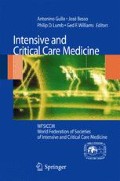Abstract
A rational resource allocation is today an imperative for intensive care medicine; resource allocation, in the intensive care unit (ICU) context, is more related to human resources availability and organization, mainly the number of trained nurses, than technology and supplies. For optimizing resources we must focus on redesigning and improving work processes. Adverse events and medical errors have arisen as a formidable problem since November, 1999, when the US Institute of Medicine released a report on medical error, “To Err is Human;” this publication was followed by several studies [1–4]. Technology complexity has improved patient prognosis but also has increased exponentially the possibility of errors and adverse events.
Access this chapter
Tax calculation will be finalised at checkout
Purchases are for personal use only
Preview
Unable to display preview. Download preview PDF.
References
Kohn LT, Corrigan JM, Donaldson MS (eds) (1999) To err is human. Building a safer health system. National Academy Press, Washington, DC
Wu A (2000) Medical error: the second victim. BMJ 320:726–727
Leape LL, Berwick DM (2000) Safe health care: are we up to it? BMJ 320:725–726
Smith R, Hiatt H, Berwick D (1999) Shared ethical principles for everybody in health care: a working draft from the Tavistock Group. BMJ 318:248–251
ATS Bioethics Task Force (1997) Fair allocation of intensive care unit resources. Am J Respir Crit Care Med 156:1282–1301
Martin W, Dünser MD, Inipavudu B et al (2006) A review and analysis of intensive care medicine in the least developed countries. Crit Care Med 34:1234–1242
Hanson CW, Deustshman CS, Anderson HL et al (1999) Effects of organized critical care services on outcomes and resources utilization: a cohort study. Crit Care Med 27:270–274
Overview of the Nursing Workforce in Latin America. Fijar numero:http://www.paho.org/English/DD/PIN/ptoday18_sep05.htmAcceded 13/04/2009
What is Behind Hrsa’s Projected Supply, Demand, and Shortage of Registered Nurses? ftp://ftp.hrsa.gov/bhpr/workforce/behindshortage.pdf Acceded 8/04/2009
Williams G, Schmollgruber S, Alberto L (2006) Consensus Forum: worldwide guidelines on the critical care nursing workforce and education standards. Crit Care Clin 22:393–406
Williams GF (1997) Labour force planning and policy development: issues for nursing. Aust Crit Care 10:43–46
Stechmiller JK (2002) The nursing shortage in acute and critical care settings. AACN Clinical Issues. Adv Pract Acute Crit Care 13:577–584
Scribante J, Schmollgruber S, Nel E (2004) Perspectives on critical care nursing: South Africa. Connect. World Crit Care Nurs 3:111–115
Albarran J, Scholes J (2005) Blurred, blended or disappearing: the image of critical care nursing. Nurs Crit Care 10:1–3
Williams G, Chaboyer W, Thornsteindottir R et al (2001) World wide overview of critical care nursing organizations and their activities. Int Nurs Rev 48:208–217
Cullen DJ, Civetta JM, Briggs BA et al (1974) Therapeutic Intervention Scoring System: a method of quantitative comparision of patient care. Crit Care Med 2:57–60
Miranda DR et al (1996) Simplified Therapeutic Intervention Scoring System: The TISS-28 items. Results from a multicenter study. Crit Care Med 24:64–73
Moreno R, Morais P (1997) Validation of the simplified therapeutic intervention scoring system on an independent database. Intensive Care Med 23:640–644
Miranda DR, Nap R, de Rijk A et al (2003) Nursing activities score. Crit Care Med 2003 31:374–382
Hanson CW, Deustshman CS, Anderson HL et al (1999) Effects of organized critical care services on outcomes and resources utilization: a cohort study. Crit Care Med 27:270–274
Weber RJ, Kane SL, Oriolo VA (2003) Impact of intensive care unit (ICU) drug use on hospital costs: a descriptive analysis, with recomeendations for optimizing ICU pharmacotherapy. Crit Care Med 31 (Suppl):S17–S24
Shah ND, Vermeulen LC, Santell JP et al (1993) Projecting future drug expenditure. Am J Hosp Pharm S6–S8
Pierpaoli PG (1993) The rising costs of pharmaceuticals: a director of pharmacy’s perspective. Am J Hosp Pharm 50:S6–S8
Rothschild JM, Landrigan CP, Cronin JWD et al (2005) The Critical Care Safety Study: the incidence and nature of adverse events and serious medical errors in intensive care. Crit Care Med 33:1694–1700
Valentin A, Capuzzo M, Guidet B et al (2006) Patient safety in intensive care: results from the multinational Sentinel Events Evaluation (SEE) study. Intensive Care Med 32:1591–1598
Vincent JL, Moreno R, Takala J et al, on behalf of the Working Group on Sepsis-Related Problems of the European Society of Intensive Care Medicine (1996) the SOFA (Sepsis-related Organ Failure Assessment) score to describe organ dysfunction/failure. Intensive Care Med 22:707–710
Miranda DR, Moreno R, Iapichino G (1997) Nine equivalents of nursing manpower use score (NEMS). Intensive Care Med 23:760–765
Kaushal R, Bates D, Franz C (2007) Costs of adverse events in intensive care units. Crit Care Med 35:2479–2483
Gallesio AO (2008) Improving quality and safety in the ICU: a challenge for the next years. Curr Opin Crit Care 14:700–707
Smith R, Hiatt H, Berwick D (1999) Shared ethical principles for everybody in health care: A working draft from the Tavistock Group. BMJ 318:248–251
Singer PA (2000) Recent advances: Medical ethics. BMJ 321:282–285
Leape LL, Berwick DM (2000) Safe health care: are we up to it? BMJ 320:725–726
Smith R, Hiatt H, Berwick D (1999) PatShared ethical principles for everybody inhealth care: A working draft from the Tavistock Group. BMJ 318:248–251
Reinertsen JL (2000) Let’s talk about error. BMJ 320:730
Society of Critical Care Medicine (1993) A model for technology assessment applied to pulse oximetry. Crit Care Med 21:615
Author information
Authors and Affiliations
Editor information
Editors and Affiliations
Rights and permissions
Copyright information
© 2009 Springer-Verlag Italia
About this chapter
Cite this chapter
Gallesio, A.O. (2009). Optimization of Limited Resources and Patient Safety. In: Gullo, A., Lumb, P.D., Besso, J., Williams, G.F. (eds) Intensive and Critical Care Medicine. Springer, Milano. https://doi.org/10.1007/978-88-470-1436-7_7
Download citation
DOI: https://doi.org/10.1007/978-88-470-1436-7_7
Publisher Name: Springer, Milano
Print ISBN: 978-88-470-1435-0
Online ISBN: 978-88-470-1436-7
eBook Packages: MedicineMedicine (R0)

